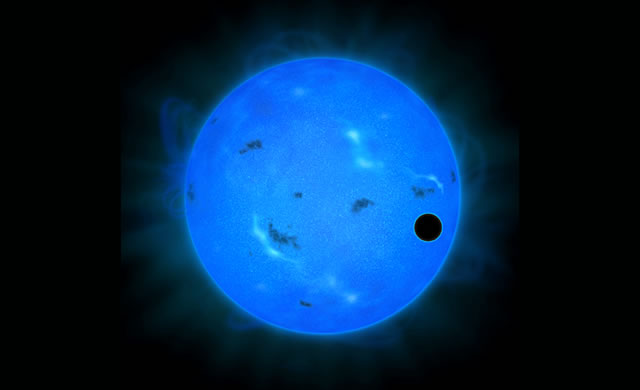
La sfera blu rappresenta la stella ospitante GJ 1214, e quella piccola scura che le orbita intorno, il pianeta GJ 1214 b.
The blue sphere represents the host star GJ 1214, and the black ball in front of it on the right is GJ 1214 b.
Credit: NAOJ
Un gruppo di ricerca giapponese composto da astronomi e scienziati planetari, ha usato due telecamere ottiche del Subaru Telescope, Suprime-Cam, la fotocamera Faint Object e lo spettrografo (FOCAS), con un filtro di trasmissione blu per osservare i transiti planetari della super Terra orbitante la stella GJ 1214 b (Gilese 1214 b). Il gruppo ha focalizzato lo studio con l’intento di rilevare se questo pianeta fosse provvisto di un’atmosfera ricca di acqua o idrogeno.
Le osservazioni effettuate tramite il Telescopio Subaru mostrano che il cielo di questo pianeta non mostra le caratteristiche che un sereno ambiente composto prevalentemente da idrogeno dovrebbe prevedere. Se combinato con i risultati di precedenti osservazioni, questo nuovo risultato d’osservazione implica che GJ 1214 b possa avere un’atmosfera ricca d’acqua. Diverse Super-Terre stanno emergendo come nuova tipologia di esopianeta (ossia un pianeta che orbita attorno ad una stella al di fuori del nostro sistema solare), con una massa e il raggio più grande della Terra, ma inferiori a quelle dei giganti di ghiaccio nel nostro Sistema Solare, come Urano o Nettuno. Che le super-Terre siano più come una “grande terra” o un “piccolo Urano” non è dato a sapere, poiché gli scienziati devono ancora determinare le loro proprietà nel dettaglio. Questo attuale gruppo di ricerca giapponese di astronomi e scienziati planetari hanno concentrato i loro sforzi sullo studio delle caratteristiche atmosferiche di una super-Terra denominata GJ 1214 b, che si trova a 40 anni luce dal nostro pianeta nella Costellazione Ofiuco, situata a nord-ovest del centro della nostra galassia, la Via Lattea .
A Japanese research team of astronomers and planetary scientists has used Subaru Telescope’s two optical cameras, Suprime-Cam and the Faint Object Camera and Spectrograph (FOCAS), with a blue transmission filter to observe planetary transits of super-Earth GJ 1214 b (Gilese 1214 b). The team investigated whether this planet has an atmosphere rich in water or hydrogen.
The Subaru observations show that the sky of this planet does not show a strong Rayleigh scattering feature, which a cloudless hydrogen-dominated atmosphere would predict. When combined with the findings of previous observations in other colors, this new observational result implies that GJ 1214 b is likely to have a water-rich atmosphere. Super-Earths are emerging as a new type of exoplanet (i.e., a planet orbiting a star outside of our Solar System) with a mass and radius larger than the Earth’s but less than those of ice giants in our Solar System, such as Uranus or Neptune. Whether super-Earths are more like a “large Earth” or a “small Uranus” is unknown, since scientists have yet to determine their detailed properties. The current Japanese research team of astronomers and planetary scientists focused their efforts on investigating the atmospheric features of one super-Earth, GJ 1214 b, which is located 40 light years from Earth in the constellation Ophiuchus, northwest of the center of our Milky Way galaxy.
Source/Continue reading → phys.org





















